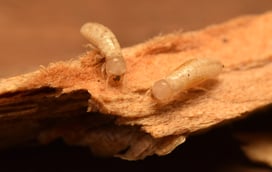The Ultimate Termite Identification Guide for Texas Homeowners
Termites are a homeowner's nightmare. These pests can cause expensive damage to your property, and often go unnoticed until it's too late. As a homeowner in Texas, it's crucial to know how to identify termites and take action immediately. In this blog post, we will provide you with the ultimate termite identification guide, including the most common types of termites found in Texas.
.jpg?width=278&height=185&name=istock_sh_termite_sm__12-col%20(1).jpg) Subterranean termites:
Subterranean termites:
This species is the most common type of termite found in Texas. They live in the soil and underground tunnels, making the infestation difficult to detect until the damage has been done. These termites build mud tubes to enter your home and feed on wooden structures. Subterranean termites have straight antennae and are creamy white to light brown in color. Their wings are the same size and are clear with a few veins. If you notice mud tubes or winged termites in your home, it's time to call a professional.

Drywood Termites:
Drywood termites are a less common but still significant threat to homeowners in Texas. Unlike subterranean termites, they do not require contact with soil and can infest any dry, untreated wood in your home. These termites are often found in attic spaces, wooden furniture, and even structural timbers.
Identifying drywood termites can be a bit trickier than other species. They have straight antennae, similar to subterranean termites, but their bodies are usually a darker brown color. However, their most distinctive feature is their wings. Drywood termites have longer wings that extend past their abdomen, and the wings have a smoky appearance with visible veins.
Since drywood termites do not create mud tubes like subterranean termites, their presence can be harder to detect. However, there are some signs to look out for. One key sign is the presence of tiny, pellet-like droppings called frass. Drywood termites push these frass pellets out of their tunnels, and they can often be found piled up beneath infested wood or furniture.
 Conehead termites:
Conehead termites:
Another non-native species that has invaded Texas, conehead termites are aggressive and can cause significant damage in a short period. They are known for building nests outside of structures and for their unique cone-shaped heads. Conehead termites have straight antennae and are creamy white to light brown in color. Their wings are light brown with visible veins.
The most common signs of a termite infestation:
The most common signs of a termite infestation can vary depending on the species and the extent of the damage. However, there are some key indicators that homeowners in Texas should be aware of. These signs can help you identify a potential termite problem and take immediate action to protect your property.

One of the most obvious signs of a termite infestation is the presence of mud tubes. Subterranean termites, the most common type in Texas, build these tubes to travel between their underground colonies and the wooden structures they feed on. These tubes are often found along the foundation of your home or in crawl spaces. If you notice these mud tubes, it is a clear indication of termite activity.
 Another sign to look out for is the presence of discarded wings. Winged termites, also known as swarmers, are reproductive termites that emerge from their nests to mate and establish new colonies. After swarming, they shed their wings, which can be found near windowsills, doors, or other areas where they have gained access to your home. If you find discarded wings, it means that termites are present and actively trying to infest your property.
Another sign to look out for is the presence of discarded wings. Winged termites, also known as swarmers, are reproductive termites that emerge from their nests to mate and establish new colonies. After swarming, they shed their wings, which can be found near windowsills, doors, or other areas where they have gained access to your home. If you find discarded wings, it means that termites are present and actively trying to infest your property.
 One less obvious sign of a termite infestation is the presence of frass. Drywood termites, in particular, push their droppings, called frass, out of their galleries. These droppings are small, pellet-like and can accumulate beneath infested wood or furniture. If you notice tiny piles of frass, it is a strong indication that drywood termites have infested your home.
One less obvious sign of a termite infestation is the presence of frass. Drywood termites, in particular, push their droppings, called frass, out of their galleries. These droppings are small, pellet-like and can accumulate beneath infested wood or furniture. If you notice tiny piles of frass, it is a strong indication that drywood termites have infested your home.
Other signs of a termite infestation may include hollow-sounding wood, sagging floors or ceilings, and small holes or tunnels in wooden structures. It is essential to be vigilant and regularly inspect your property for any signs of termite activity. Early detection is crucial in preventing extensive damage and costly repairs.
If you suspect a termite infestation, it is always best to contact a professional pest control company. They have the expertise and tools to accurately identify the type of termite and provide effective treatment options. Remember, DIY treatments may not be effective in eradicating the infestation, and it is better to rely on professionals to protect your home and investment.
By staying informed and proactive against termites, you can safeguard your property and have peace of mind knowing that you are taking the necessary steps to prevent termite damage.
Interested in Termite Control In Cleburne Texas? CLICK HERE
Termite LifeCycle

.png?width=200&height=109&name=Abbys%20Logo%20-%20New%20-%20A%20SafeHaven%20Company%20(1).png)